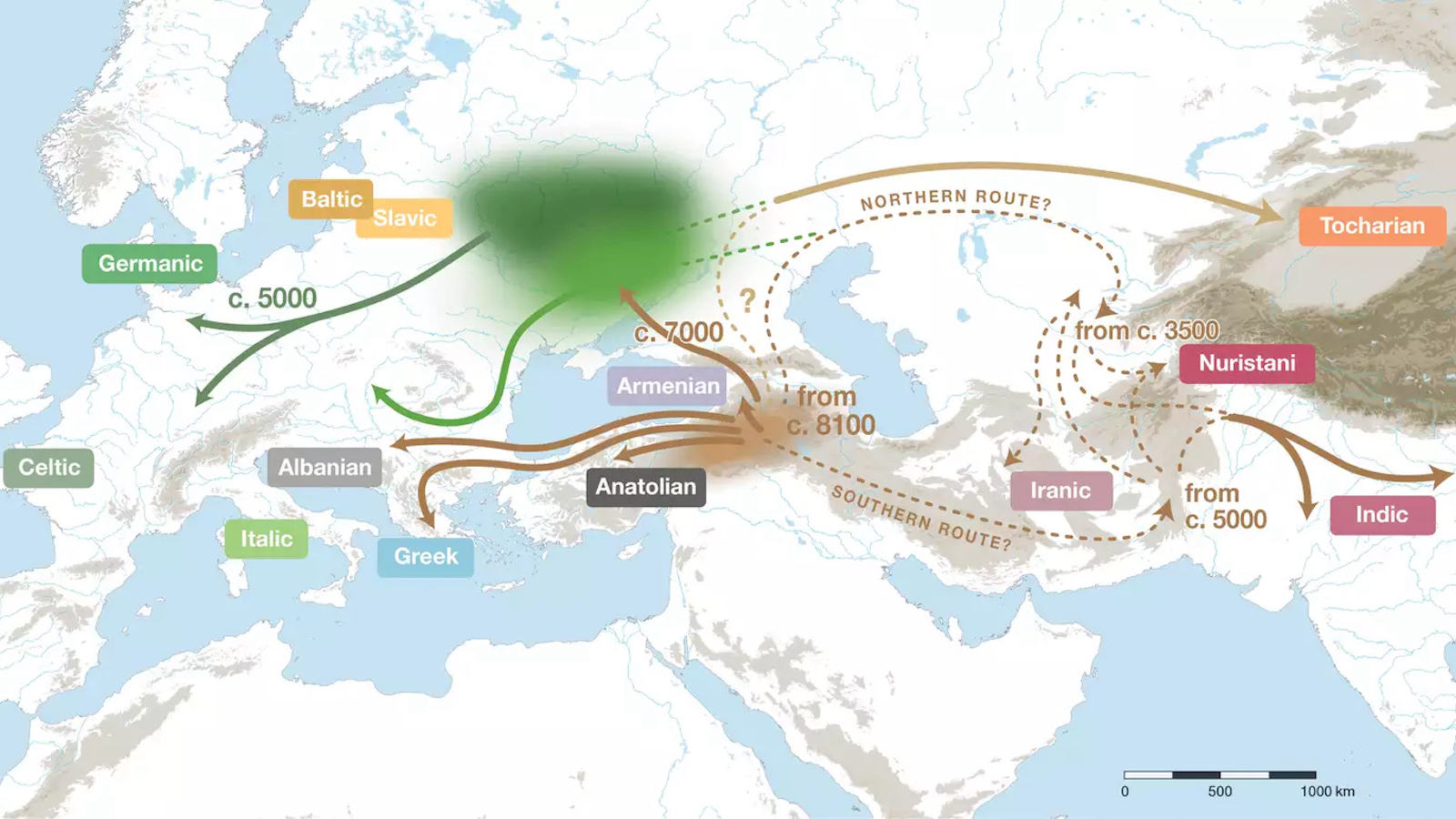Half of All Languages Come from One Root Language. How it Spread Is Something of Debate

The sheer variety of languages on Earth is dizzying in their array and divergence. What’s more intriguing, is that about half of them spoken today by some three billion people, come from a single root language, used thousands of years ago. Hindi, Bengali, Persian, English, German, Spanish, and Greek, all come from the same root, known as Proto-Indo-European (PIE). In total, 400 languages and dialects originate from PIE.
German linguist August Schleicher reconstructed its vocabulary back in 1868. He wondered what PIE sounded like. So he created a fable called “The Sheep and the Horses.” Over the years, as more information has been unearthed about the Bronze Age cultures who spoke this language, the fable has been updated. Of course, scholars argue over what PIE actually sounded like. Nothing is definitive. But we have an approximation.
Here’s the latest recording of spoken PIE performed by University of Kentucky linguist Andrew Byrd:
Here is the English translation:
The Sheep and the Horses
A sheep that had no wool saw horses, one of them pulling a heavy wagon, one carrying a big load, and one carrying a man quickly. The sheep said to the horses: “My heart pains me, seeing a man driving horses.” The horses said: “Listen, sheep, our hearts pain us when we see this: a man, the master, makes the wool of the sheep into a warm garment for himself. And the sheep has no wool.” Having heard this, the sheep fled into the plain.
Linguists, anthropologists, and other scholars are working on piecing together what seems a near impossible puzzle. Despite the difficulties in studying a long forgotten tongue, they’ve made great progress. How it began and when other languages began to break off is still a mystery. Today, there are two prevailing theories.
One says PIE formed in an area known as the Pontic-Caspian Steppe, a sprawling grassland north of the Black and Caspian Seas, which today encompasses parts of Russia, the Ukraine, and Kazakhstan. Beginning circa 6,500–5,500 bp (before present), a tribe of nomads began speaking PIE, the theory states. They domesticated horses and learned to ride them.
Two studies help support the so-called Steppe Hypothesis. One is linguistic the other genetic. In this view, the nomads moved West conquering lands and peoples, and spreading their “cultural innovations,” including wheeled vehicles, horse domestication, and wool weaving.
UC Berkeley researchers, led by linguist Will Chang, completed one study published in 2015 in the journal Language. It offers compelling evidence supporting the Steppe Hypothesis. He and colleagues took 207 words from 150 Indo-European languages. Some were from dead languages, others are still spoken today.
Researchers used these words as data and evaluated them using statistical modeling. They wanted to find out how quickly the words changed over time. From there, Chang and colleagues discovered that the first linguistic divergence occurred c. (circa) 6,500 years ago. By cross-referencing these findings with an analysis of the Indo-European language tree, Chang and colleagues concluded that conquering Indo-Europeans spread PIE as they moved westward.
The Steppe Hypothesis. By: Joshua Jonathan (Own work) [CC BY-SA 4.0], via Wikimedia Commons
Another study adds evidence to the Steppe side of the argument. Published in the journal Nature in 2015, researchers, led by David Reich of Harvard, conducted genetic testing on 69 ancient Eurasian mummies, who lived 8,000 to 3,000 years ago. Reich distinguished himself recently by discovering that certain ailments, including hay fever, derive from Neanderthal genes.
He and his team included the famous glacier mummy Ötzi, who has something of a cult following. Discovered in the Alps, Ötzi met his ghastly end 5,300 years ago. Researchers also poured through all previous genomic research of this kind. They found that European hunter-gatherers came from the Yamnaya steppe in Russia, appearing around 6,000 to 5,000 years ago. These herders originated in the Near East.
Then, somewhere around 4,500 years ago, a group known as the Corded Ware people, famous for their pottery, could be found living in parts of northern Europe, including Germany. This study suggests that the Yamnaya Steppe people swept through from the East, settling Europe, and so in essence became the Corded Ware people. Most Europeans today can actually trace their ancestry back to the Corded Ware people, genetic evidence suggests.
Indo-European expansion according to the Anatolian Hypothesis. via Wikimedia Commons
In 2012, a team of evolutionary biologists from the University of Auckland, New Zealand, produced evidence disputing the Steppe Hypothesis. Instead of the grasslands of Asia, their research points to Turkey as the place where PIE took root, c. 9,500–8,000 bp. This is known as the Anatolian Hypothesis.
Using linguistic data and computational methods, researchers determined that PIE was spoken among settled farmers who had domesticated animals. As their innovations spread, so did their language. Both camps offer compelling evidence. Though the Harvard study may add just a tad more credence to the Steppe Hypothesis, these two are currently still locked in a scholarly “tug of war.”
To learn how language itself may have spread, click here:





